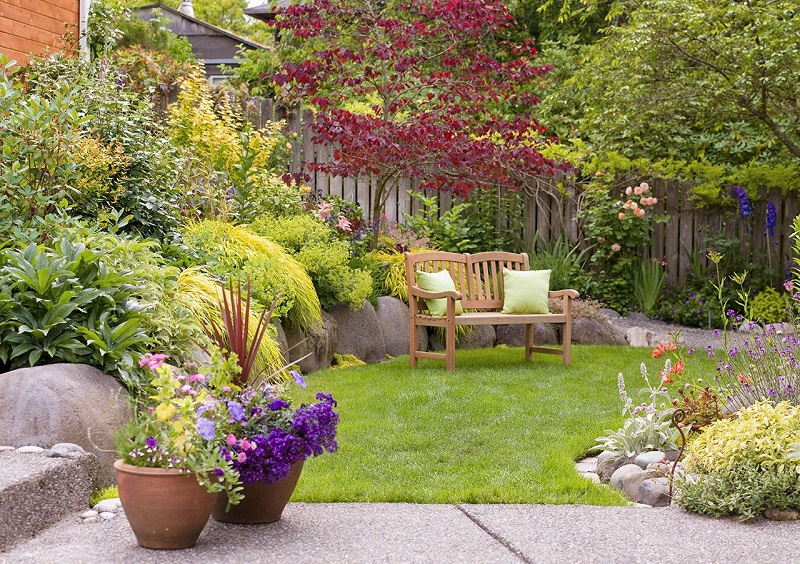Landscaping on a Slope: Creative Ideas and Techniques

A garden set on a slope can feel like a puzzle, but it’s one worth solving. The very angles and curves that seem difficult at first can be the key to something extraordinary.
With the right ideas and a little patience, challenging ground can become your most captivating feature.
Understanding the Land Before You Begin
Every successful design starts with getting to know the space. Measuring the slope accurately will guide every decision you make, from plant choice to pathways.
Gentle inclines lend themselves to sweeping, informal layouts, while steeper ground calls for careful steps to keep soil and structure in place.
Once you know the gradient, take time to explore the soil itself. Check pH levels, nutrient content, and how well it drains. Healthy ground supports healthy plants, and any shortcomings can be corrected with compost or other amendments.
Observing how rainwater flows, or testing with a hose, will help you plan drainage as well.
Additionally, it’s worth noting how sunlight moves across the slope during the day. South-facing slopes often receive more light and warmth, which can suit Mediterranean-style planting, while north-facing ones may be better for shade-tolerant species.
Wind exposure is another factor. Gusts can dry out soil quickly and damage delicate plants, so positioning windbreaks or choosing hardier varieties can help.
When the terrain is particularly complex, the expertise of professional garden landscapers can turn a difficult site into a masterpiece. They can combine technical skill with creative vision, ensuring every element works in harmony with the land.
Choosing Plants That Work with the Slope
Selecting plants for a slope is as much about resilience as about beauty.
Native and well-adapted varieties tend to thrive without constant attention, while their root systems help to anchor the soil.
Low-growing ground covers such as creeping thyme or sedum are especially useful for holding the earth in place while adding colour and texture.
To create depth, mix plants of varying heights and shapes. Tall ornamental grasses can sway above clusters of lavender or hardy perennials, forming a rich, layered tapestry.
This variety not only pleases the eye but also encourages beneficial insects and pollinators, keeping pests in check and the garden in balance.
For additional interest, you might incorporate plants that provide seasonal change—spring bulbs for early colour, summer-flowering perennials for vibrancy, and autumn foliage for warmth before winter arrives.
Where the slope is more arid, drought-tolerant species such as rosemary or echinacea can add structure without demanding excessive watering. Meanwhile, in wetter sections, moisture-loving plants like astilbe or hostas can create lush, textural contrasts.
Building Terraces and Walls for Shape and Stability
Terracing can transform an awkward slope into a series of level, usable spaces.
Each terrace slows water runoff, reduces erosion, and offers a dedicated area for planting or seating. Retaining walls perform a similar role, supporting the ground while adding a strong visual element.
The choice of material shapes the character of the garden. Stone blends seamlessly with natural surroundings, timber brings warmth, and concrete offers a crisp, modern look.
Whichever you choose, ensure proper drainage with discreet gaps or perforations so water can pass through without damaging the structure. Done well, these features feel like part of the land rather than an interruption.
Beyond functionality, terracing opens opportunities for thematic planting.
One level could hold a herb garden close to the kitchen, another might feature a colourful wildflower meadow, while a lower terrace could provide a shaded seating area for hot summer afternoons.
Integrating lighting along walls or steps improves safety and turns the slope into an evening showpiece.
Protecting the Slope from Erosion
Keeping soil in place is essential on any incline.
In the early stages, simple defences such as silt fences can slow water and catch loose earth. For a more natural touch, biodegradable jute mats allow rain to filter through while holding the soil until plants establish themselves.
Deep-rooted species offer another layer of defence, binding the ground with their underground networks. Hardy grasses, shrubs, and certain flowering plants all work well, turning potential problem areas into thriving pockets of greenery.
Furthermore, adding mulch around plants helps retain moisture, suppress weeds, and reduce the impact of heavy rainfall on bare soil.
For particularly steep or vulnerable sections, combining several erosion-control methods—such as ground covers, mats, and contour planting—can provide stronger protection than relying on one approach alone.
Regular checks will ensure these measures remain effective and attractive over time.
Designing Spaces that Feel Part of the Landscape
Paths, steps, and seating areas on a slope should follow the land’s contours, creating a sense of ease and connection.
Gentle curves are kinder on the legs and more pleasing to the eye than abrupt, straight climbs. Materials such as stone or brick provide durability, while the addition of handrails can make steeper sections safer.
Seating can be woven into the structure itself, perhaps as a bench set into a retaining wall or a level terrace with a simple timber seat.
Beyond that, choosing finishes that echo other elements in the garden helps these features blend naturally with their surroundings, making them feel like an intentional part of the design.
For further charm, consider integrating water features or small sculptures along pathways, encouraging visitors to pause and enjoy the journey.
Lighting can also play a role in drawing the eye to focal points and extending the use of the garden into the evening.
Guiding Water to Help the Garden Thrive
Water will always travel downhill, so the aim is to work with it rather than against it.
To begin with, swales or shallow planted channels, slow the flow and allow it to soak into the soil. When placed with the slope’s shape in mind, they protect vulnerable spots and create planting opportunities.
In the same way, rain gardens can make use of wetter areas, filling them with plants that tolerate both damp and dry spells.
Furthermore, roof runoff can be channelled into these areas through planned guttering, thereby turning what could be waste into a valuable resource.
As a result, good water management safeguards both the structure of the slope and the long-term health of the plants.
In addition to these measures, installing drip irrigation systems on sloped beds can provide consistent moisture without causing soil washout.
Finally, using water butts to collect rainwater is a sustainable way to supply these systems, reducing reliance on mains water while making the most of natural rainfall.
Conclusion
A sloping garden isn’t a problem to solve; it’s a character to embrace.
With clever planting, thoughtful structures, and a dash of ingenuity, the land starts to work with you rather than against you.
Give it care and creativity, and it will reward you with a space that’s brimming with charm year after year.

